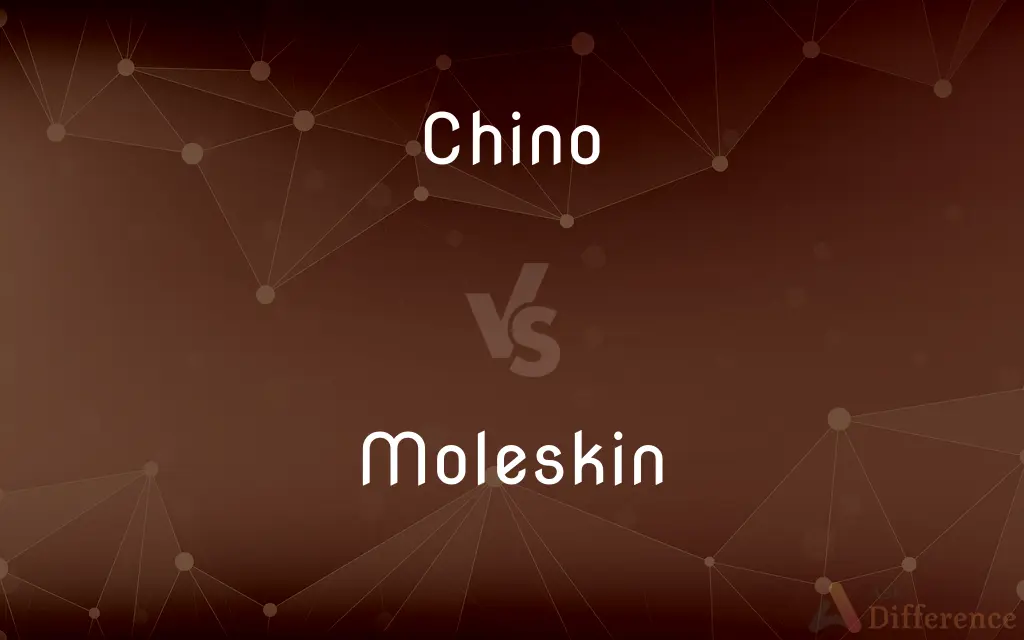Chino vs. Moleskin — What's the Difference?
By Fiza Rafique & Urooj Arif — Updated on April 5, 2024
Chino is a lightweight cotton twill fabric, commonly used for casual or semi-formal pants, while moleskin is a heavy cotton fabric, brushed for softness, ideal for durable and warm clothing.

Difference Between Chino and Moleskin
Table of Contents
ADVERTISEMENT
Key Differences
Chino fabric originates from the military uniforms of the mid-19th century, valued for its durability and ease of cleaning. On the other hand, moleskin is known for its soft, suede-like finish, resulting from a brushing process that raises the nap of the cotton weave, offering exceptional warmth and protection against cold weather.
Chino pants are a staple in casual and business casual wardrobes, characterized by their lightweight, breathable nature, making them suitable for warmer climates. Conversely, moleskin pants are sought after for colder environments, as their thick, insulating fabric provides substantial warmth.
The production of chino involves tightly weaving cotton fibers to create a durable yet comfortable fabric. Moleskin, however, undergoes an additional process where one side of the fabric is brushed to create a short, soft pile, mimicking the feel of a mole's skin, which enhances its thermal properties and resistance to wind.
Chino fabric is versatile, used not only in pants but also in uniforms, jackets, and even home decor due to its ease of dyeing in various colors. Whereas moleskin is predominantly used in the manufacture of heavy-duty workwear, outdoor clothing, and protective garments, favored for its robustness and soft texture.
In terms of care, chino garments are relatively low-maintenance, often machine washable and requiring minimal ironing, reflecting their utilitarian origins. Moleskin, while also durable, may require more careful cleaning to preserve its plush pile and rich texture, sometimes recommending dry cleaning to avoid shrinking and maintaining its soft feel.
ADVERTISEMENT
Comparison Chart
Material
Lightweight cotton twill
Heavy cotton with a brushed, soft surface
Origin
Mid-19th century military uniforms
Traditionally used in workwear and for protection
Climate Suitability
Warm climates, spring and summer
Colder environments, autumn and winter
Texture
Smooth, with a slight sheen
Soft, suede-like, with a plush pile
Common Uses
Casual and business casual pants, jackets, uniforms
Workwear, outdoor clothing, protective garments
Compare with Definitions
Chino
Known for breathability, chinos are ideal for warm weather.
Chino shorts are a staple in any summer wardrobe.
Moleskin
Moleskin is a heavy cotton fabric with a brushed, soft surface.
His moleskin jacket kept him warm during the winter hike.
Chino
Chino fabric is versatile, used in both clothing and decor.
The designer incorporated chino fabric into the room's upholstery for a durable finish.
Moleskin
Predominantly used in durable workwear and outdoor clothing.
The construction workers wore moleskin overalls for added protection.
Chino
Easily dyed, chinos come in a variety of colors.
She picked out a vibrant blue chino skirt for her brunch outfit.
Moleskin
Moleskin requires careful cleaning to maintain its texture.
To preserve its softness, his moleskin coat is always dry cleaned.
Chino
Chino refers to a durable, lightweight cotton twill fabric.
He wore a pair of khaki chino pants to the summer picnic.
Moleskin
Renowned for its warmth, moleskin is perfect for cold climates.
She bought a pair of moleskin pants for her trip to the mountains.
Chino
Chino garments are low-maintenance and easy to care for.
The best thing about his chino trousers is that they're machine washable.
Moleskin
The fabric undergoes brushing for a suede-like finish.
The softness of the moleskin fabric is due to its carefully brushed pile.
Chino
A coarse twilled cotton fabric used for uniforms and sometimes work or sports clothes.
Moleskin
Moleskin is a heavy cotton fabric, woven and then sheared to create a short, soft pile on one side. The feel and appearance of its nap is similar to felt or chamois, but less plush than velour.
Chino
Chinos Pants made of a coarse twilled cotton.
Moleskin
The short, soft, silky fur of a mole.
Chino
A coarse cotton fabric commonly used to make trousers and uniforms.
Moleskin
A heavy-napped cotton twill fabric.
Chino
A coarse, tough, twilled cotton fabric used for uniforms or sports clothes.
Moleskin
Moleskins Clothing, especially trousers, of this fabric.
Chino
A coarse twilled cotton fabric used for uniforms
Moleskin
A soft material, often with an adhesive backing, used especially on the feet to protect against chafing.
Moleskin
The fur of a mole.
Moleskin
A cotton twill fabric with a heavy velvety nap.
Moleskin
Clothing made of this fabric.
Moleskin
A padded adhesive bandage used to prevent or treat blisters.
Moleskin
To cover with a moleskin bandage.
Moleskin
Any fabric having a thick soft shag, like the fur of a mole; esp., a kind of strong twilled fustian.
Moleskin
A soft fabric having an adhesive backing, applied to the skin at points susceptible to abrasion, as on the feet, to prevent irritation or blistering during exercise, such as hiking.
Moleskin
A durable cotton fabric with a velvety nap
Common Curiosities
How do chino and moleskin fabrics differ in use?
Chino fabric is versatile, suitable for a wide range of clothing including pants and jackets for warm climates, whereas moleskin is primarily used in protective workwear and clothing for colder conditions.
Can chino and moleskin fabrics be used in the same types of garments?
While both fabrics can be used in pants and jackets, their different properties make them suited to different environments; chino for lighter, more breathable garments, and moleskin for warmer, heavier-duty wear.
How should I care for chino and moleskin garments?
Chino garments are generally machine washable and easy to maintain, while moleskin may require more specific care, such as gentle washing or dry cleaning, to preserve its texture and avoid shrinkage.
What is chino fabric?
Chino is a lightweight, durable cotton twill fabric, often used in casual and business casual attire for its comfort and ease of care.
What is moleskin fabric?
Moleskin is a dense, heavy cotton fabric known for its soft, brushed surface that provides warmth and protection, commonly used in workwear and cold-weather clothing.
Are chino and moleskin suitable for formal wear?
Chino can be adapted for semi-formal occasions, especially in neutral colors like khaki or navy. Moleskin, due to its heavy and casual nature, is less commonly used in formal wear.
Is moleskin actually made from moles?
No, moleskin is made from cotton and gets its name from its soft, velvety surface that resembles the feel of a mole's fur, not from actual mole skin.
Which fabric is more durable, chino or moleskin?
Both fabrics are known for their durability, but moleskin's dense weave and brushed surface give it an edge in terms of protection and resistance to wear.
What are the environmental impacts of chino and moleskin production?
Both fabrics are cotton-based, so their environmental impact depends on farming practices, water usage, and chemical treatments used during production. Sustainable options are available for both fabrics.
Can chino or moleskin shrink after washing?
Chino fabric generally resists shrinking, especially if pre-treated. Moleskin can shrink if not cared for properly, so it's important to follow specific washing instructions.
Share Your Discovery

Previous Comparison
Offer vs. Offers
Next Comparison
Tudung vs. MalaysiaAuthor Spotlight
Written by
Fiza RafiqueFiza Rafique is a skilled content writer at AskDifference.com, where she meticulously refines and enhances written pieces. Drawing from her vast editorial expertise, Fiza ensures clarity, accuracy, and precision in every article. Passionate about language, she continually seeks to elevate the quality of content for readers worldwide.
Co-written by
Urooj ArifUrooj is a skilled content writer at Ask Difference, known for her exceptional ability to simplify complex topics into engaging and informative content. With a passion for research and a flair for clear, concise writing, she consistently delivers articles that resonate with our diverse audience.
















































